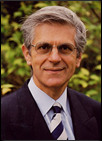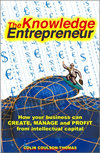 |
 |
|
 |
Creating a Compelling Vision
By Professor Colin Coulson-Thomas
Are your people, and those with whom you deal, clear about what
your organisation is endeavouring to achieve? Colin Coulson-Thomas author
of a new guide to competing and winning* reveals what leaders of the most
successful companies do differently when setting about the strategically
important task of visioning.
A stretching, distinctive and compelling vision that paints a picture
of a future, desired and attainable state of affairs can engage and motivate.
A clear vision is of value internally and externally. Internally it motivates
people to achieve and focus their efforts, while externally the vision
should differentiate a company from its competitors.
The board is primarily responsible for formulating and agreeing a company’s
strategic vision and ensuring its implementation. In some companies particular
individuals have been given the specific task of ensuring that a corporate
vision remains current and vital. These keepers of the vision attract
various job titles. At USA.net someone known as the Chief Visionary undertakes
the role.
A vision should capture the essence of what a company is all about. At
the start of the new millennium Steve Ballmer became CEO of Microsoft.
His predecessor Bill Gates a co-founder of the company assumed the title
of chairman and chief software architect. The latter role allows Gates
to return to his roots and the activities he most enjoys. It also reflects
the importance of a strategic vision in the development of new technologies.
Some visions motivate more than others. Staff at the BBC became much more
engaged when the public broadcaster’s vision was changed from ‘to
be the best managed organisation in the public sector’ and became
‘to be the world’s most creative organisation’. A vision
and a mission statement should balance the needs of both individuals and
the organisation along the lines of Amazon’s ‘Work Hard, Have
Fun, Make History’.
Internally and externally, the common and shared element of a vision should
be a unifying factor. It should hold a diverse, complex and network form
of organisation together and provide its people with a sense of common
purpose. Yet while a vision can inspire, it can also result in disillusionment
and distrust if it is incomplete or incapable of achievement, and there
is a gap between aspiration and attainment.
So what do the winners do differently in relation to visioning? To answer
these questions a research programme led by the author has examined the
corporate experience of over 2,000 companies. The results are summarized
in: ‘Transforming the Company, Manage Change, Compete and Win’*.
The corporate visions of losers are often little more than words on paper.
Most are instantly forgettable. A bland statement produced during an off-site
‘planning day’ is printed on a card and distributed to staff.
Although it may make occasional appearances in corporate brochures it
is rarely referred to. Whatever ‘visioning exercise’ was undertaken
is viewed as a one-off event. The outputs may linger on in unchanged form
long after they have ceased to reflect what is possible, current or desirable.
Loser companies often lack a distinctive or compelling reason for existing.
They are one of a kind or breed. They are not noticeably special or unique.
People find it difficult to justify why they should join it, work with
it, use its services or invest in it. Perhaps the initial underlying business
concept lacked originality. Maybe it simply mirrored what competitors
were already doing.
The wider world tends not to care when losers falter. External parties
may have little interest in keeping such an enterprise alive. The corporate
herd continues as individual stragglers fall by the wayside. Even failure
may go largely unnoticed. While employees lose their jobs customers may
be able to obtain very similar products and services from other suppliers.
Many of the key players within loser companies are uncertain and insecure.
They lack self-confidence and have little self-esteem. Other people have
little interest or faith in them. They themselves are not really sure
what they are about. In difficult circumstances they may not have sufficient
inner conviction or do enough to keep the enterprise alive. They throw
in the towel and are relieved when shot of onerous responsibilities.
Losers can appear dull, resigned and subdued. They drift. They seem to
lack drive, personality, heart and soul. Senior managers in corporate
losers become preoccupied with ‘fitting in’, ‘hanging
onto customers’, ‘papering over cracks’ and surviving.
After a time they lose sight of corporate objectives and lose touch with
past dreams and their inner selves.
In contrast, winners are confident, vibrant and driven. They fizz and
are clear about what they are seeking to achieve. They are much more likely
to have articulated a unique rationale. They endeavour to root their visions
in real customer requirements. When it is described, people react. They
usually understand it and they appreciate what is special about it.
Managers in winning companies feel important and wanted. They ensure that
employees and business partners know what they have to do to bring a vision
about. The vision lives and motivates because while it may be challenging
it is also regarded as relevant and exciting. People are proud to be associated
with it.
Winners stand out. They strive to be different. From the moment she first
arrived in New York Madonna endeavoured to meet the people who mattered.
She registered and was remembered. Her single-minded determination to
build her personal brand has made her a global icon. Richard Branson’s
ballooning exploits have helped to keep his name in front of the public
and entrench his reputation as a business leader who is different from
the traditional ‘suit’.
Winning businesses connect. They also contribute. Their people try to
make them special and unique. Customers may find it difficult to obtain
similar goods and services elsewhere. They would certainly notice and
be inconvenienced if the enterprise failed. Like investors they want it
to do well.
When a winner stumbles other people catch their breath. They are concerned.
Because it’s role and contribution is important to them a variety
of ‘interested parties’ including customers, suppliers and
business partners might be willing to provide temporary support during
difficult times. Because business fundamentals and the critical success
factors for competitiveness are in place investors may be willing to provide
additional funding to allow a winning company to ride out an occasional
storm.
Winners never rest on their laurels or become complacent. Their people
are restless. They search, test, learn and apply. Directors of winning
companies are much more likely to regularly review their vision, purpose,
key corporate goals and strategies during board meetings to ensure they
are still current and relevant. If they are found wanting people throughout
the organisation make whatever changes are necessary to reflect altered
conditions and evolving requirements.
They are also much more confident, and less likely to ‘cut and run’
in crisis situations. Obstacles, difficulties and the unknown invariably
confront those who venture ahead of the pack. People in winning companies
derive self-worth and inner strength from the knowledge that their organisation
is valued and needed. Senior managers do not need to play games or pretend
the know things. They trust their instincts and are not afraid to be themselves.
Eternal parties who deal with winners know where they stand with them.
While they may be flexible and prepared to bend so far in the search for
accommodation they are unwilling to compromise cherished principles and
core values. They also avoid promising more than they can deliver.
Winners are determined. Like a predator they play to their strengths and
can also be patient when waiting for the right moment to go after an opportunity.
They acknowledge and confront challenges. In difficult times they are
open and honest with those whose support they seek. They tell it as it
is and share rather than conceal reality as they understand it. As a consequence,
they are more likely to receive help when they ask for it.

Professor Colin Coulson-Thomas |
About the Author:
Prof. Colin Coulson-Thomas, an experienced company chairman, has
advised over 90 boards and management teams on director, board and
corporate development. Formerly the world’s first Professor
of Corporate Transformation and Process Vision Holder of major transformation
projects, he is the UK’s first Professor of Competitiveness
and can be contacted:
Tel: 01733 361 149
Fax: 01733 361 459
Email: colinct@tiscali.co.uk
Web: www.ntwkfirm.com/colin.coulson-thomas
*‘Transforming the Company, Manage Change, Compete and Win’
by Colin Coulson-Thomas and published by Kogan Page can be ordered
by Tel. 01903 828800; Fax. 020 7837 6348; E-mail: orders@lbsltd.co.uk
or on-line at www.ntwkfirm.com/bookshop
|
|
Transforming the Company: Manage Change, Compete & Win
Colin Coulson-Thomas shows that to bridge the gap between rhetoric
and reality, business people must make far-reaching decisions about
the value to them and their companies of particular theories, past
assumptions and traditional approaches. Based on original research,
the first edition of this was ahead of its time and predicted many
of the current management trends. The author now brings the text bang
up-to-date for the 21st century. This second edition of Transforming
The Company shows how to turn theory into practice by highlighting
the obstacles and barriers that confront companies when trying to
bring about change. For management at all levels faced with this task,
this thought-provoking book will inspire and enlighten. |
| 
Buy
UK Buy
US
|
The Knowledge Entrepreneur: How Your Business Can Create,
Manage and Profit from Intellectual Capital
In many companies knowledge management has focused almost exclusively
upon the packaging of existing knowledge. This book is designed
to help readers boost revenues and profit by significantly improving
the performance of existing activities and also creating new offerings
that generate additional income. It shows how practical knowledge-based
job-support tools can transform work group productivity, and reveals
the enormous scope for addressing contemporary problems such as
"information overload" with imaginative responses. Additional
information includes: a list of possible commercial ventures; detailed
checklists that can be used for identifying and analysing opportunities
for knowledge entrepreneurship; and exercises for assessing entrepreneurial
potential and "scoping" possible products and services.
The free CD-ROM packaged with the book gives examples of particular
knowledge-based job support tools that have dramatically improved
desired results in crucial areas such as winning more business.
|

top of page |
 |
